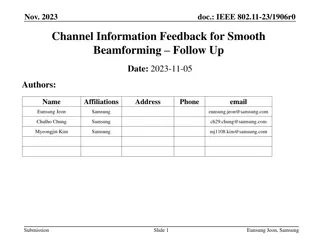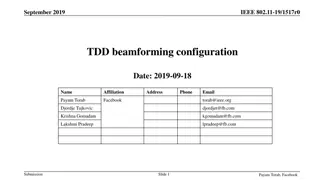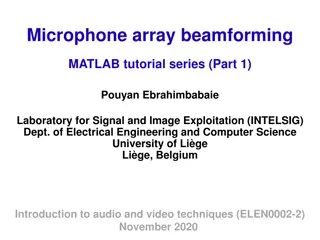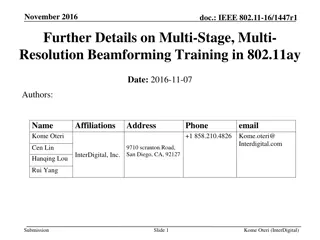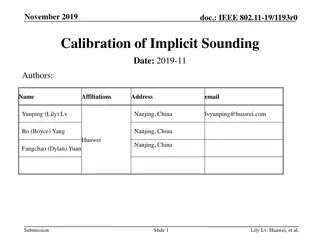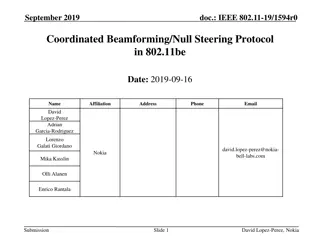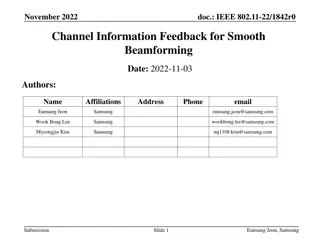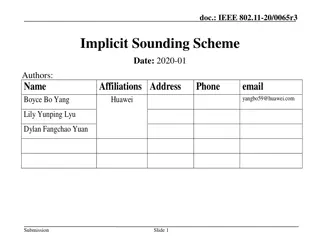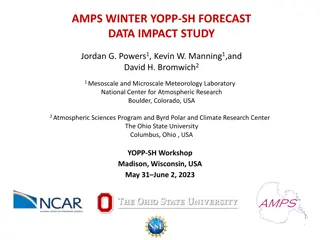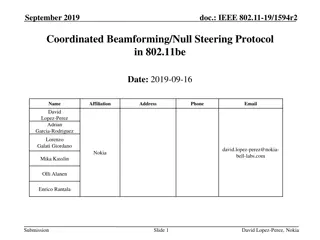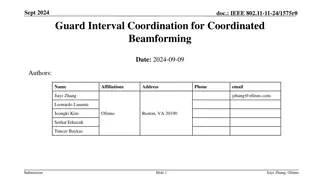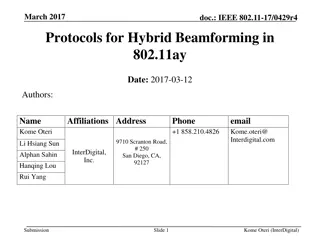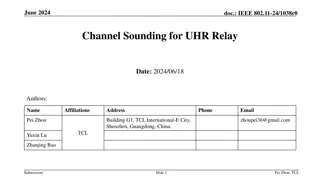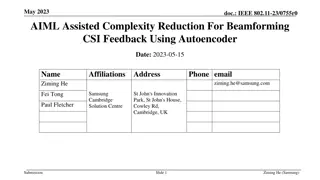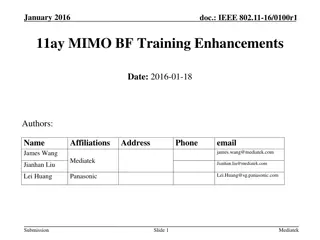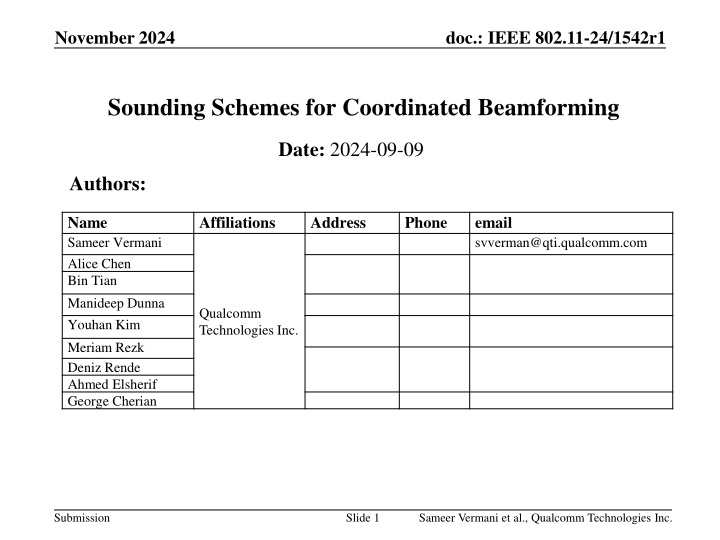
IEEE 802.11-24 Sounding Schemes for Coordinated Beamforming in November 2024
Explore the innovative sounding sequences proposed by Qualcomm Technologies Inc. for Coordinated Beamforming in IEEE 802.11-24 standard in November 2024. The presentation covers terminology, limitations, and performance benefits of joint sounding in multi-AP setups. Discover the strategies and scenarios for full-rank and partial-rank nulling with detailed insights on the number of APs in COBF transmissions.
Download Presentation

Please find below an Image/Link to download the presentation.
The content on the website is provided AS IS for your information and personal use only. It may not be sold, licensed, or shared on other websites without obtaining consent from the author. If you encounter any issues during the download, it is possible that the publisher has removed the file from their server.
You are allowed to download the files provided on this website for personal or commercial use, subject to the condition that they are used lawfully. All files are the property of their respective owners.
The content on the website is provided AS IS for your information and personal use only. It may not be sold, licensed, or shared on other websites without obtaining consent from the author.
E N D
Presentation Transcript
November 2024 doc.: IEEE 802.11-24/1542r1 Sounding Schemes for Coordinated Beamforming Date: 2024-09-09 Authors: Name Sameer Vermani Alice Chen Bin Tian Manideep Dunna Youhan Kim Meriam Rezk Deniz Rende Ahmed Elsherif George Cherian Affiliations Address Phone email svverman@qti.qualcomm.com Qualcomm Technologies Inc. Submission Slide 1 Sameer Vermani et al., Qualcomm Technologies Inc.
November 2024 doc.: IEEE 802.11-24/1542r1 Introduction A motion passed in last TGbn session to include multi-AP Coordinated Beamforming (COBF) in UHR In these slides, we propose sounding sequences for COBF Outline Define some terminology Limitation on number of APs Propose two types of sounding sequences Sequential NDP based sounding Joint NDP based sounding Performance benefits of joint sounding Conclusions Submission Slide 2 Sameer Vermani et al., Qualcomm Technologies Inc.
November 2024 doc.: IEEE 802.11-24/1542r1 Terminology: Full-rank Nulling AP1 and AP2 have 4 Tx antennas each STA1 and STA2 have 2 Rx antennas each Scenario 1: AP1 and AP2 form nulls to both the eigen modes of STA2 and STA1 respectively We call this case as the full-nulling scenario, where all eigen modes to the OBSS STA are being nulled to AP2 AP1 STA1 (2Rx) STA2 (2Rx) BSS2 BSS1 Submission Slide 3 Sameer Vermani et al., Qualcomm Technologies Inc.
November 2024 doc.: IEEE 802.11-24/1542r1 Terminology: Partial-rank Nulling AP1 and AP2 have 4 Tx antennas each STA1 and STA2 have 2 Rx antennas each Scenario 2: AP1 and AP2 form nulls to only one of the eigen modes of STA2 and STA1 respectively We call this case as the partial-rank nulling scenario, where only a subset of the eigen modes to the OBSS STA are being nulled to AP2 AP1 STA2 STA1 BSS2 BSS1 Submission Slide 4 Sameer Vermani et al., Qualcomm Technologies Inc.
November 2024 doc.: IEEE 802.11-24/1542r1 Number of APs in a COBF transmission We suggest restricting COBF transmissions to two APs Protocol and STA side complexity reasons Note that one AP can still perform COBF with different APs at different times, but only with one other AP in each transmission One AP can perform setup of COBF with multiple APs as well to maximize COBF opportunities Submission Slide 5 Sameer Vermani et al., Qualcomm Technologies Inc.
November 2024 doc.: IEEE 802.11-24/1542r1 Sequence Flavor 1: Sequential NDP based sounding Design assumptions Would like to avoid NDPA to address OBSS STAs Power-save concerns (reading of all OBSS packets is a heavy burden on the STA) No need to exchange the per-STA stream allocation at the sounding stage From STA view: uses legacy sounding procedures as canonical components as-is Below we show the case of 1 STA per BSS with some key attributes NDPA only addresses the in-BSS STAs Sounding happens for one BSS s STAs at a time Note: Additional MAC related frames may be needed BSS 2 STAs being sounded BSS 1 STAs being sounded NDP BF RP NDPA BF RP NDPA NDP AP1 BF RP BF RP NDPA NDP NDPA NDP AP2 STA1 associated with AP1 CSI CSI STA2 associated with AP2 CSI CSI Submission Slide 6 Sameer Vermani et al., Qualcomm Technologies Inc.
November 2024 doc.: IEEE 802.11-24/1542r1 Pros and cons: Sequential Sounding flavor Pros Uses existing sounding protocol components from the point of view of the STA 4ss-sounding-capable STAs can also participate in CoBF sounding involving two 4Tx APs Con Does not work well with partial-rank nulling scenarios Explanation of partial rank-nulling issue with sequential sounding Partial-rank null being formed to the OBSS STA implies an eigen mode with high interference at the STA This eigenmode may have a high projection on the in-BSS signal s spatial signature leading to loss of in-BSS signal strength to avoid high interference Submission Slide 7 Sameer Vermani et al., Qualcomm Technologies Inc.
November 2024 doc.: IEEE 802.11-24/1542r1 Sequence Flavor 2: Joint NDP based sounding Design assumptions Would like to avoid NDPA to address OBSS STAs Power-save concerns (reading of all OBSS packets is a heavy burden on the STA) No need to exchange the per-STA stream allocation at the sounding stage From STA view: uses legacy sounding procedures as canonical components as-is Below we show the case of 1 STA per BSS with some key attributes NDPA only addresses the in-BSS STAs Sounding happens for one BSS s STAs at a time Joint NDP based feedback will be based on large V-based feedback where the eigen-vectors span the antennas across both APs BSS 1 STAs being sounded Note: Additional MAC related frames may be needed BSS 2 STAs being sounded NDP BF RP NDPA NDP AP1 NDPA BF RP NDP NDP AP2 STA1 associated with AP1 Large V based feedback STA2 associated with AP2 Large V based feedback Submission Slide 8 Sameer Vermani et al., Qualcomm Technologies Inc.
November 2024 doc.: IEEE 802.11-24/1542r1 Pros and cons: Joint Sounding flavor Pros Uses existing sounding protocol components from the point of view of the STA Works well with partial nulling case as global CSI knowledge can be utilized with a common U for both in-BSS and OBSS components of the channel Con Does not work for 4ss-sounding-capable STAs and needs 8ss-sounding-capable STAs for the case of two 4Tx APs Submission Slide 9 Sameer Vermani et al., Qualcomm Technologies Inc.
November 2024 doc.: IEEE 802.11-24/1542r1 Need for partial-rank nulling case Traffic/latency constraints may necessitate a partial nulling scenario as we might be transmitting 1ss to 2Rx STAs Full nulling takes up more dimensions at the AP thereby making reducing opportunities for CoBF usage in field E.g., with a 4Tx AP, we cannot do full-nulling to two 2Rx STAs in the OBSS and transmit to in-BSS STA at the same time Additionally, we run simulations to show why it is necessary to support partial nulling cases (through joint sounding) Compared the following for two 4Tx APs, and 2Rx STAs [2,2] ss allocation with full-nulling using sequential sounding [1,1,1,1] ss allocation with partial nulling using joint sounding Results on next slide Submission Slide 10 Sameer Vermani et al., Qualcomm Technologies Inc.
November 2024 doc.: IEEE 802.11-24/1542r1 Performance benefits of partial-nulling Configuration Two 4 Tx APs STAs with 2 Rx each -30 dBc channel aging 40MHz MU-MIMO D-NLOS channels We plot 10th percentile of the network throughput (sum at the two APs) Observation For the same total number of streams, partial nulling can have a huge performance benefit Submission Slide 11 Sameer Vermani et al., Qualcomm Technologies Inc.
November 2024 doc.: IEEE 802.11-24/1542r1 Conclusion We showed detailed designs for the two possible sounding sequences for COBF in UHR Sequential NDP based sounding Joint NDP based sounding Both the sounding sequences have pros and cons Sequential sounding works well with lower sounding-capability STAs but does not work well for partial-rank nulling case Joint sounding works well for partial-rank nulling case but needs higher capability STAs Showed the importance of supporting partial-rank nulling scenario Suggest supporting both kinds of sounding sequences in UHR Submission Slide 12 Sameer Vermani et al., Qualcomm Technologies Inc.
November 2024 doc.: IEEE 802.11-24/1542r1 New section in r1 document : Relevant to COBF Sounding CFO ISSUES Submission Slide 13 Sameer Vermani et al., Qualcomm Technologies Inc.
October 2024 doc.: IEEE 802.11-24/1542r1 Joint Sounding protocol needs CFO Pre- correction of NDP frames Sounding happens one BSS at a time Below shows the 2 AP, 1STA per AP case NDP BF RP NDPA NDP Sharing AP1 NDPA BF RP NDP NDP Shared AP2 This frame is transmitted at the same pre-correction as previous NDP STA1 associated with AP1 Needs precorrection to bring within 350 Hz Large V based feedback STA2 associated with AP2 Large V based feedback Results on next slide Submission Slide 14 Sameer Vermani et al., Qualcomm Technologies Inc.
March 2024 doc.: IEEE 802.11-24/1542r1 Impact of 350 Hz CFO during joint NDP Below we show the Rx sensitivity loss for MCS9 and MCS11 at 10% PER Isolation (dB) 5 10 15 20 MCS9 4 dB 0 dB 0 dB 0 dB MCS11 >10% Err Floor 5 dB 0.5 dB 0 dB Conclusion: 350 Hz can be tolerated, for MCS9 with 10 dB isolation and for MCS11 with 15 dB isolation Submission Slide 15 Sameer Vermani et al., Qualcomm Technologies Inc.
October 2024 doc.: IEEE 802.11-24/1542r1 Sequential Sounding CFO Issues Sounding happens one BSS at a time (shown by BRCM[1]) Below shows the 2 AP, 1STA per AP case Phase 1 sounds STA1 in BSS1 and phase 2 sounds STA2 in BSS2 Phase 1 Phase 2 Sharing AP1 NDP BF RP NDPA BF RP NDPA NDP BF RP BF RP NDPA NDP NDPA NDP Shared AP2 STA1 associated with AP1 CSI CSI STA2 associated with AP2 CSI CSI If the two APs just transmit NDPs at their frequency, the feedback tones at the two APs may differ by up-to 40ppm During actual transmission stage, we will have to make shared AP synchronize to sharing AP for the joint LTF phase Ran sims to evaluate performance impact of precoding tones being different than transmission tones Submission Slide 16 Sameer Vermani et al., Qualcomm Technologies Inc.
October 2024 doc.: IEEE 802.11-24/1542r1 Quantifying the impact of CFO in Sequential Sounding 2AP, 1 STA per AP, 3ss total, 4Tx per AP, full nulling case, no isolation Impact of one AP s precoding happening on tones which are certain number of tones apart from the transmission tones About 20% loss in throughput from 3-tone/234 kHz (~40 ppm) offset Need to do some pre-correction during sequential sounding Isolation helps (see appendix) but we cannot design a system which works only for >10 dB isolation Slide 17 Submission Sameer Vermani et al., Qualcomm Technologies Inc.
October 2024 doc.: IEEE 802.11-24/1542r1 Possible solution for the sequential sounding CFO Issues Phase 2 Phase 1 Sharing AP1 NDP BF RP NDPA BF RP NDPA NDP CFO Precorrection BF RP BF RP NDPA NDP NDPA NDP Shared AP2 CFO Precorrection STA1 associated with AP1 CSI CSI STA2 associated with AP2 CSI CSI All NDP frames are synced to sharing AP (transmitter of the first NDPA) First yellow NDP needs to perform pre-correction to sync to the green NDPA before it Second yellow NDP needs to use the same pre-correction as the one during first yellow NDP Shared AP needs to remember the correction from the phase 1, to use it during the second phase when it is the transmitter of the NDP Slide 18 Submission Sameer Vermani et al., Qualcomm Technologies Inc.
November 2024 doc.: IEEE 802.11-24/1542r1 SP1 Do you support limiting the coordinated beamforming (COBF) transmission phase in 802.11bn to 2 APs only? Submission Slide 19 Sameer Vermani et al., Qualcomm Technologies Inc.
November 2024 doc.: IEEE 802.11-24/1542r1 SP2 Do you agree to include both sequential NDP based and joint NDP based sounding options for COBF in UHR? Submission Slide 20 Sameer Vermani et al., Qualcomm Technologies Inc.
November 2024 doc.: IEEE 802.11-24/1542r1 SP3 Do you agree with the sequential NDP based sounding protocol shown below for COBF? Sounding happens one BSS at a time NDPA only addresses the in-BSS STAs MAC related additional frames are TBD NDP BF RP NDPA BF RP NDPA NDP AP1 BF RP BF RP NDPA NDP NDPA NDP AP2 STA1 associated with AP1 CSI CSI STA2 associated with AP2 CSI CSI Submission Slide 21 Sameer Vermani et al., Qualcomm Technologies Inc.
November 2024 doc.: IEEE 802.11-24/1542r1 SP4 Do you agree that for joint NDP based sounding, one AP will frequency synchronize to the other for both of its NDP transmissions? For both the NDPs, the AP doing the correction brings its frequency within in a certain TBD range of the reference AP Submission Slide 22 Sameer Vermani et al., Qualcomm Technologies Inc.
November 2024 doc.: IEEE 802.11-24/1542r1 SP5 Do you agree with the joint NDP based sounding protocol shown below for COBF? Sounding happens one BSS at a time NDPA only addresses the in-BSS STAs MAC related additional frames are TBD Joint NDP based feedback will be based on large V-based feedback where the eigen-vectors span the antennas across both APs NDP BF RP NDPA NDP AP1 NDPA BF RP NDP NDP AP2 STA1 associated with AP1 Large V based feedback STA2 associated with AP2 Large V based feedback Submission Slide 23 Sameer Vermani et al., Qualcomm Technologies Inc.
November 2024 doc.: IEEE 802.11-24/1542r1 SP6 Do you agree that for sequential NDP based sounding, one AP will frequency synchronize to the other for both of its NDP transmissions? For both its NDPs, the AP doing the correction brings its frequency within in a certain TBD range of the reference AP Submission Slide 24 Sameer Vermani et al., Qualcomm Technologies Inc.
November 2024 doc.: IEEE 802.11-24/1542r1 SP7 Do you support that in the UHR sounding process for COBF, for the joint sounding case as well as for the sequential sounding case, the NDP shall always carry the BSS color of the AP which transmitted the NDPA ? Submission Slide 25 Sameer Vermani et al., Qualcomm Technologies Inc.


